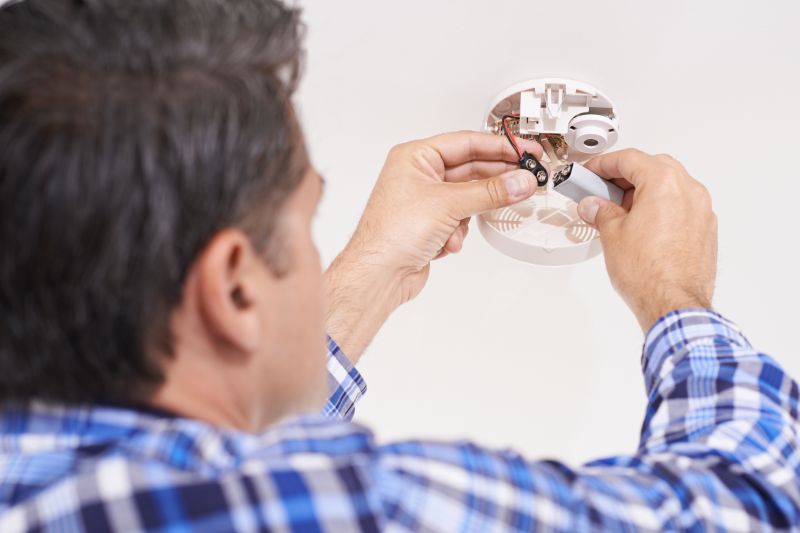Expert Picks For Reliable Smoke And Fire Alarm Installation Products
Choose from a curated list of trusted products that ensure your smoke and fire alarms are installed correctly and effectively.
 Selecting the right products for smoke and fire alarm installations is essential for ensuring safety and compliance within residential and commercial spaces. These products encompass a wide range of devices designed to detect smoke, heat, or fire, and to alert occupants promptly. Proper installation and maintenance of these devices can significantly enhance safety measures, providing early warnings that can make a critical difference in emergency situations. When choosing equipment, it is important to consider factors such as device sensitivity, power sources, and compatibility with existing systems.
Selecting the right products for smoke and fire alarm installations is essential for ensuring safety and compliance within residential and commercial spaces. These products encompass a wide range of devices designed to detect smoke, heat, or fire, and to alert occupants promptly. Proper installation and maintenance of these devices can significantly enhance safety measures, providing early warnings that can make a critical difference in emergency situations. When choosing equipment, it is important to consider factors such as device sensitivity, power sources, and compatibility with existing systems.
Top Overall Option
Multi-Function Smoke and Heat Detector
A versatile device combining smoke detection with heat sensing capabilities, this detector offers comprehensive coverage for various environments. Its multi-sensor technology helps reduce false alarms and provides reliable alerts. Designed for easy installation and integration with existing alarm systems, it is suitable for both residential and commercial settings, offering a balanced approach to safety without making promises of guarantees.
Types of Products For Smoke And Fire Alarm Installations
Wired Smoke Detectors
Hardwired with battery backup, these detectors are connected directly to the building's electrical system for consistent operation.
Wireless Smoke Detectors
Battery-powered or Wi-Fi enabled, these detectors offer flexible placement options and easy integration with smart home systems.
Combination Smoke and Carbon Monoxide Detectors
Devices that monitor both smoke and carbon monoxide levels, providing dual safety functions in one unit.
Heat Detectors
Sensors that respond to rapid temperature increases, typically used in kitchens or garages to avoid false alarms.
Photoelectric Smoke Detectors
Utilize light sensors to detect smoke particles, effective for slow-burning fires.
Ionization Smoke Detectors
Use ionization chambers to detect smoke from flaming fires, often more sensitive to fast-burning fires.
Smart Smoke Alarms
Wi-Fi enabled devices that can send alerts to smartphones and integrate with home automation systems.
Interconnected Alarms
Multiple alarms linked together so that when one detects smoke, all alarms sound simultaneously.
Voice Alert Smoke Detectors
Alarms that provide spoken alerts to specify the type of danger or location.
Dual-Sensor Detectors
Combine photoelectric and ionization sensors for comprehensive fire detection.
Carbon Monoxide Detectors
Devices dedicated to detecting dangerous levels of carbon monoxide in indoor spaces.
Emergency Lighting Integration
Systems that combine smoke detection with emergency lighting for safe evacuation.
Portable Smoke Alarms
Battery-operated units suitable for temporary or rental spaces, easy to move as needed.
Popular Choices
Popular for their ease of installation and smart home compatibility, offering flexible coverage options.
Trending for their connectivity features, allowing remote monitoring and alerts via mobile devices.
Chosen for their ability to synchronize alarms across multiple rooms, enhancing safety coordination.
Increasingly popular for providing dual detection in a single device, streamlining safety measures.
Favored for their sensitivity to slow-burning fires and reduced false alarms.
Commonly used for fast-flaming fires, appreciated for their quick response times.
Preferred in areas prone to false alarms from smoke, such as kitchens and garages.
Getting attention with spoken warnings, especially useful for hearing-impaired individuals.
Popular for their comprehensive detection capabilities, combining multiple sensing technologies.
Essential in homes with fuel-burning appliances, widely used for their safety benefits.
Modern smoke and fire alarm products include various types of detectors, control panels, and accessories that work together to create comprehensive safety networks. Wireless options offer flexibility for installation in hard-to-reach areas or where wiring is impractical, while wired systems tend to provide more stable connections and are often preferred in larger buildings. Many devices now incorporate features like voice alerts, interconnected alarms, and smart home integration, allowing users to monitor and control their safety devices remotely.
Installation considerations extend beyond selecting the right products. Proper placement is crucial to ensure optimal coverage and early detection. Typically, smoke alarms should be installed on every level of a building, inside bedrooms, and outside sleeping areas. Heat detectors are often used in kitchens or garages where smoke alarms might produce false alerts. Regular testing, battery replacements, and adherence to manufacturer guidelines are vital to maintaining the effectiveness of these safety devices. Investing in high-quality products with reliable performance can contribute to a safer environment for all occupants.
Ultimately, choosing the appropriate smoke and fire alarm products involves evaluating the specific needs of your space, understanding the different types of detectors available, and ensuring compatibility with your existing safety systems. By making informed decisions, you can establish a robust safety network that provides peace of mind and enhances overall protection in your home or business.
Key Buying Considerations
- Compatibility with existing alarm systems and home automation setups
- Type of detection technology (photoelectric, ionization, or dual sensors)
- Power source options such as battery, wired, or hybrid systems
- Ease of installation and maintenance requirements
- Interconnectivity features for multiple alarms to work together
- Additional alerts like voice notifications or smart device integration
- Coverage area and the appropriate number of detectors needed
- False alarm reduction features to prevent nuisance triggers
- Compliance with local safety codes and standards
- Battery life and backup options for uninterrupted operation
- Ease of testing and resetting the alarms
- Size and design to match interior aesthetics
- Price range and long-term reliability
- Availability of customer support and warranty services
- Additional features such as carbon monoxide detection or heat sensing
